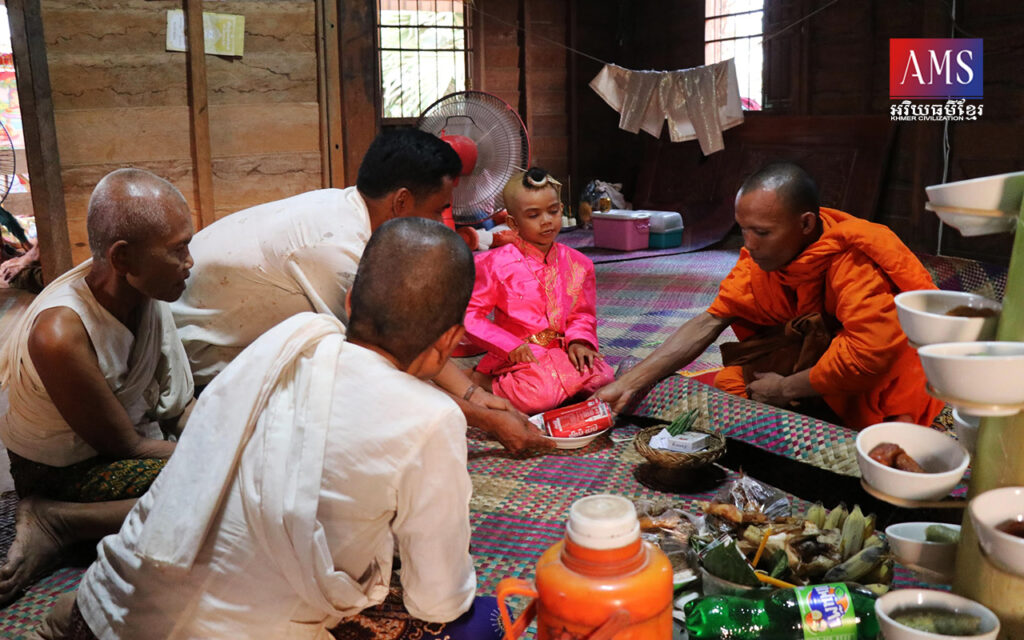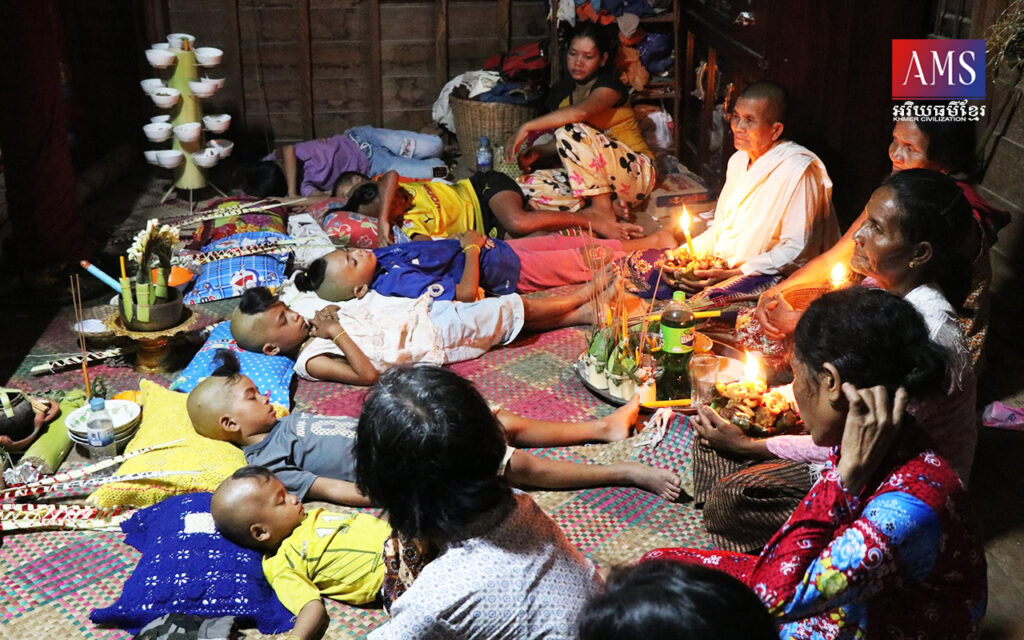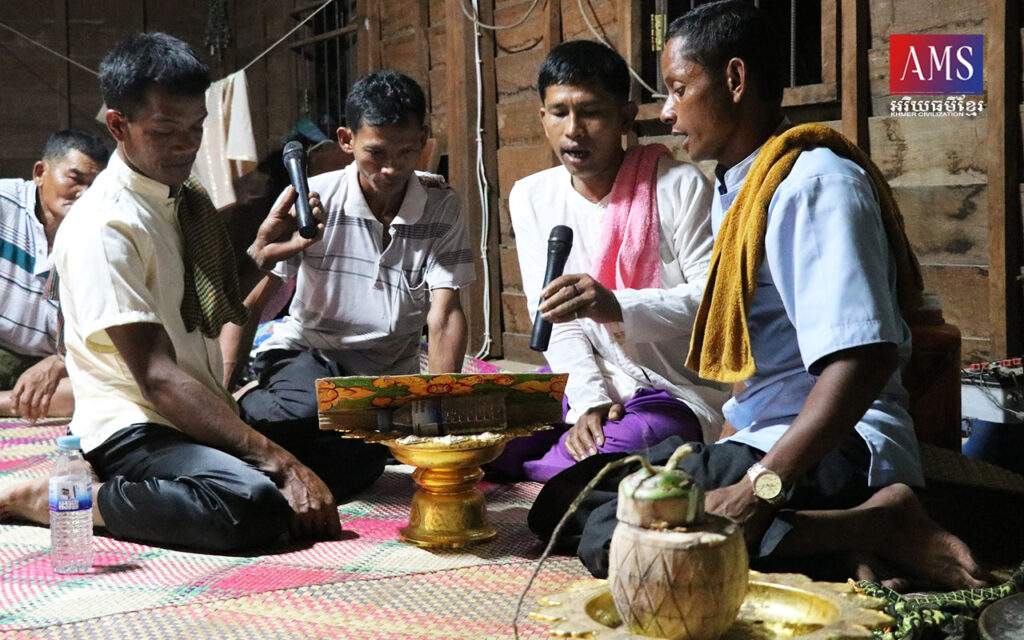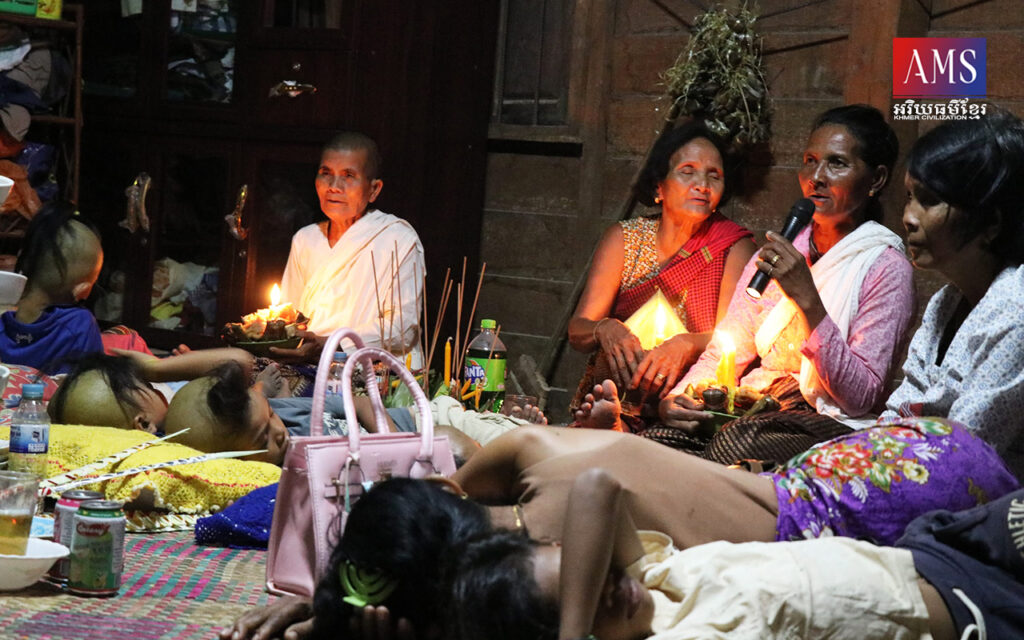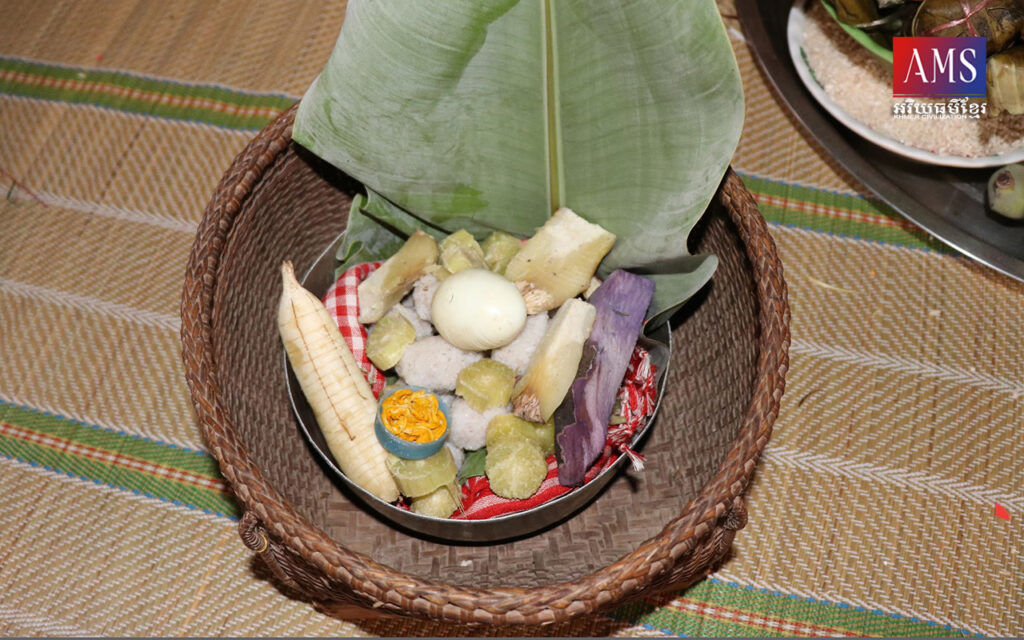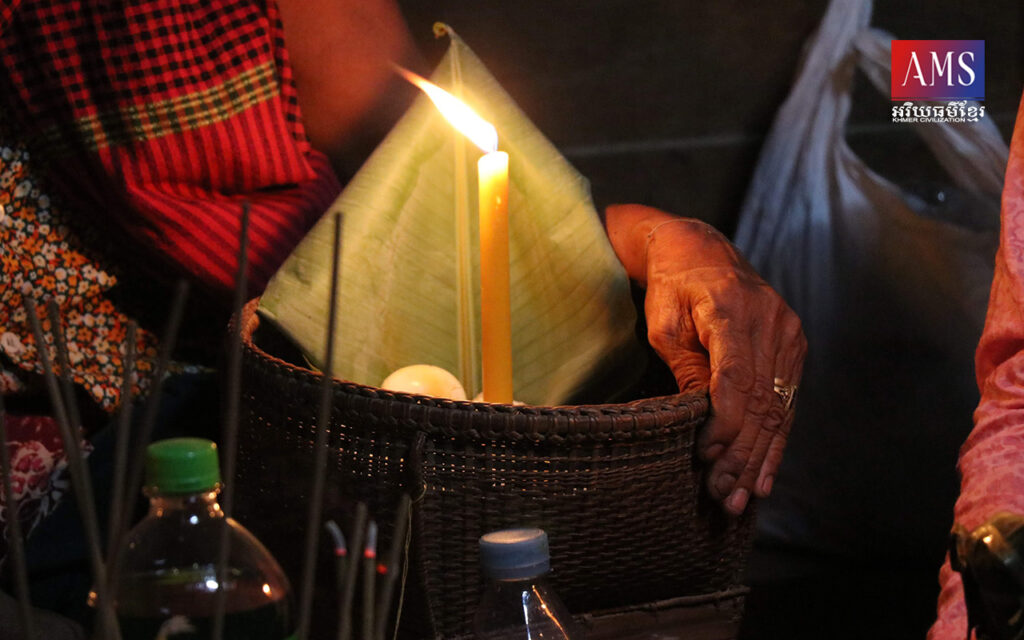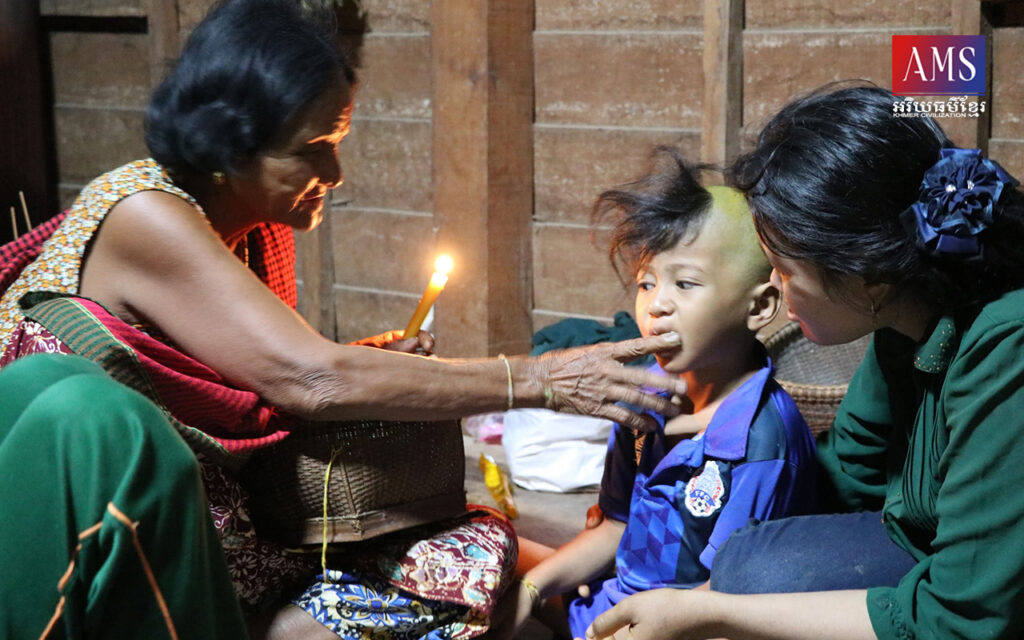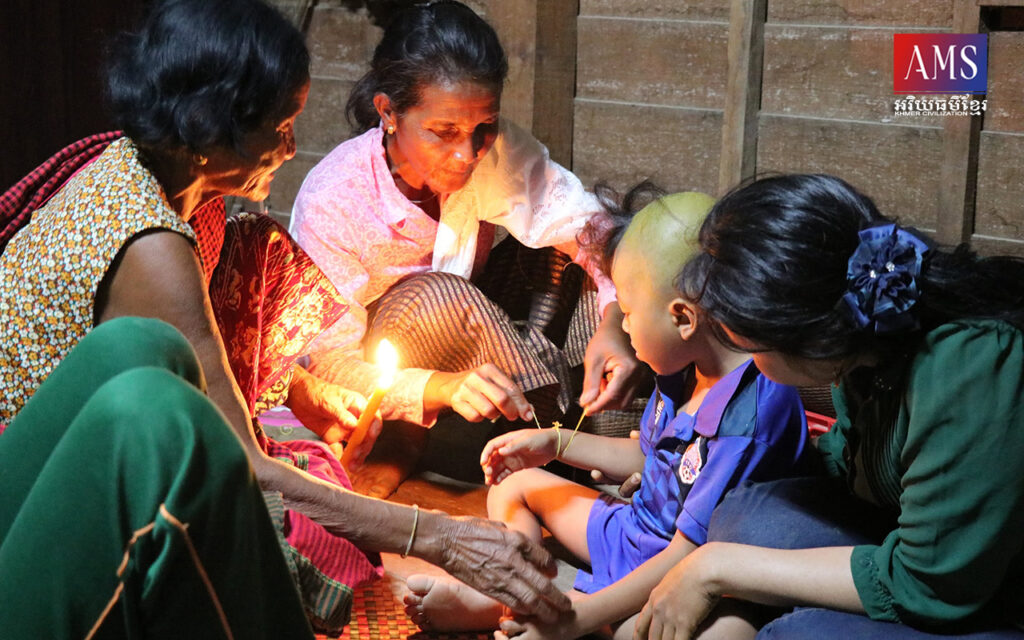គេហទំព័រ អេ អឹម អេស អរិយធម៌ខ្មែរ (AMS Khmer Civilization) យើងខ្ញុំធ្លាប់បានចុះផ្សាយអំពីពិធី “កោរជុក” ម្តងរួចមកហើយ។ នៅក្នុងពិធីកោរជុក មានកិច្ចច្រើនណាស់ដែលត្រូវប្រារព្ធ ហើយបើពិនិត្យដោយសង្ខេបគេឃើញមានកិច្ចចំនួនបីប៉ុណ្ណោះ ដែលមានវត្តមានព្រះសង្ឃ ពោលគឺក្នុងកិច្ចសូត្រមន្តនៅព្រលប់ថ្ងៃទី១ និងកិច្ចផ្តាច់ជុក រួចរាប់បាត្រព្រះសង្ឃនៅព្រឹកថ្ងៃបង្ហើយ។ រីឯកិច្ចដទៃទៀតគឺមានតែអាចារ្យ និងចាស់ទុំដែលចេះច្បាប់ក្បួនជាអ្នករៀបចំ ដ្បិតមានកិច្ចខ្លះពិបាកនឹងយល់ន័យអស់ផង។ កិច្ចទាំងនោះរួមមាន ប្រុងពលី (ឬក្រុងពាលី) សែនមារការ សែនដូនតា បង្វិលពពិលអង្កររាប ដេកអង្កររាប ហៅព្រលឹងសក់ ជញ្ជាត់ព្រលឹង រាវអង្កររាប ធ្វើធ្មេញ ។ល។
ពាក់ព័ន្ធនឹងពិធីកោរជុកនេះ អ្នកស្រាវជ្រាវបានរកឃើញន័យផ្សេងៗគ្នា។ ពាក្យថា “ជុក” គឺនិយាយតាមពាក្យថាជាទូទៅ ឯអ្នកស្រុកនៅតំបន់ខាងជើង និងភាគពាយព្យ ប្រទេសច្រើនហៅថា “កំប៉ោយ” ឬ “កំប៉ោច” ហើយបើគេចង់និយាយពីកិច្ចពិធីកាត់កំប៉ោចជាស្ថាពរនោះ គេច្រើននិយាយសាមញ្ញថា “កោរសក់”។ រីឯអ្នកស្រុកខ្លះថា “កោរសក់” ឬ “កោរកំប៉ោយ” ហើយ “ជុក” ឬ “កំប៉ោយ” ជាសក់មួយដុំ ឬច្រើនដុំ (អស់ច្រើន៣ដុំ) ដែលក្មេងប្រុសស្រីទុកនៅលើក្បាលចាប់ពីអាយុ៣ឆ្នាំ រហូតដល់ធំឡើងទើបកោរ។ ប៉ុន្តែយ៉ាងណាក៏ដោយគេមើលឃើញដូចគ្នាថា “កោរជុក” ជាពិធីរៀបចំសម្រាប់ក្មេងទាំងស្រីទាំងប្រុសមុនពួកគេឈានដល់ដំណាក់កាលពេញវ័យ ដែលគេនឹងត្រូវឆ្លងកាត់កិច្ចពិធីផ្សេងៗជាច្រើនតទៅទៀត។
ដោយឡែក “កិច្ចហៅព្រលឹងសក់” គឺជាកិច្ចមួយដែលប្រារព្ធក្នុងពិធីកោរជុកនាវេលាអាធ្រាត្រ បន្ទាប់ពីកិច្ចដេកអង្កររាប។ មកដល់ត្រង់នេះគេគួរយល់ដែរថា ក្នុងជំនឿខ្មែរ “ព្រលឹង” ពិបាកនឹងពន្យល់ថាជាអ្វីឱ្យប្រាកដណាស់ តែខ្មែរយល់ដូចគ្នាថាមនុស្សម្នាក់ៗមានព្រលឹងចំនួន១៩ ហើយបើព្រលឹងរលោះពីខ្លួន (ហៅថាលោះព្រលឹង) នោះម្ចាស់ខ្លួននឹងពុំមានសុខភាពរឹងមាំឡើយ។ រីឯ “សក់” វិញសោត ខ្មែរយល់ថាមានន័យវែងឆ្ងាយខ្លាំងណាស់ ដ្បិតគេតែងសង្កេតឃើញមនុស្សខ្លះកាត់ឱ្យខ្លី (មិនមែនកាត់ឱ្យស្អាតស្អំក្នុងទស្សនៈសោភណភាព) មនុស្សខ្លះកោរ ឯមនុស្សខ្លះទុកសក់ឱ្យវែងពុំហ៊ានប៉ះពាល់ឡើយ ហើយខ្មែរក៏តែងមានកិច្ចតាមទំនៀមជាច្រើនពាក់ព័ន្ធនឹងសក់ តាំងពីកើតមកជាទារកជាហូរហែមកដែរ។
ចំពោះកិច្ចហៅព្រលឹងសក់នេះ គេធ្វើពេលក្មេងដេក ហើយអាចារ្យតែងនាំគ្នាសូត្រ មានបែបបទលើកដាក់សំឡេងយឺតៗ និងមានអ្នកចាំបន្ទរត្រង់ឃ្លាមានពាក្យថា “ព្រលឹង”។ឃ្លាបន្ទរមានជាអាទិ៍ “មកវើយ ព្រលឹងសក់! មើលកុក មើលទុង មើលជ្រុងទន្លេ កុំទៅតាមគេ មកផ្ទះយើងវិញ” ឬបន្ថែមថា “នៅផ្ទះយើងធំស្រណុក ស៊ីចេកអំបុក ស៊ីត្រាវដំឡូង ស៊ីចេកដេកនៅ ស៊ីអំពៅដើរលេង គេហៅកុំដោយ រមិលមើលក្រោយ រក្សារូបរក្សាអង្គ” ជាដើម។ ឃ្លាបន្ទរ ហាក់មានន័យបារម្ភខ្លាចព្រលឹងរលោះចេញពីក្មេង មិននៅរក្សារូបកាយក្មេងទាំងនោះ។ ការសូត្រហៅព្រលឹងនេះចាយពេលប្រហែលជាង១ម៉ោង តែបើអានធម្មតាប្រហែលជាង១០នាទីប៉ុណ្ណោះ។ រីឯរណ្តាប់សំខាន់ក្នុងកិច្ចនេះគឺ បាយព្រលឹង និងបាយសីដើម ហើយក្រោយបញ្ចប់ពាក្យសូត្រ គេតែងដាស់ក្មេងឱ្យងើបពីដេក និងយកបាយព្រលឹងនោះបញ្ចុកគ្រប់ៗគ្នា មានដូចជា កំណាត់អំពៅ ចេកទុំ ដំឡូង ត្រាវ និងពំនូតបាយជាដើម។ បាយព្រលឹងនេះ រៀបចំឡើងដើម្បីសម្តែងឱ្យឃើញថាព្រលឹងទាំងអម្បាលម៉ាននៅមូលជុំគ្នា ទន្ទឹមនឹងពេលចប់កិច្ចគេតែងស្រាយបាសីដើម រួចលើករំលងក្មេង៣ដង ទើបយកទៅចោល ដ្បិតជានិមិត្តរូបថាអាត្មាចាស់នៃក្មេងម្នាក់ៗកន្លងហួសហើយ៕
————————————————————————
Calling hair soul in the cutting of the Top-Knot ceremony
There is a lot of rites to be done in the cutting of the Top-Knot ceremony. These rites include Krong Pali, sacrificing the ancestor, the passing of the Popil, Daek Angkaw Reap, calling the hair soul, finding Trol in Angkaw Reap, making teeth. Regarding the cutting of the Top-Knot ceremony, researchers have found different meanings. The word “Chuk” is a common word, and the people in the north and northwest of the country often call it “Kampoy” or “Kampoch” and if they want to talk about the ceremony of cutting the Kampoch, they often say simply “shave hair.” Some locals call it “shave hair” or “shave Kampoch” and “Chuk” or “Kampoy” as one or more pieces of hair (more than three pieces) that boys and girls keep on their heads from the age of three years old and their hair will be shaved when they are adult. However, it is also seen that “the cutting of the Top-Knot” is a ceremony for children, both boys and girls, before they reach adulthood, they will have to go through many other rites.
In particular, the “calling the hair soul” is a rite that is celebrated in the cutting of the Top-Knot ceremony at midnight after the sleep on Angkaw Reap. At this point, it should be understood that in the Khmer belief, “soul or Pralung” is difficult to explain for sure, but Cambodians agree that each person has 19 souls and if the soul is lost from the body (called lose soul or Loh Pralung) that is the owner of the body will not be healthy. As for “hair”, Khmer people understand that it is deep meaning because it is often observed that some people cut hair short (not for good looking), some people shave and some people keep their hair long and do not dare to touch it. And Khmer also has a lot of traditional rites related to hair from birth as a baby.
As for the call for the hair soul, it is done when the boys or girls are asleep, and the Acha always prays in a slow manner and there are people who chorus the phrase “Pralung”. The chorus phrases include, “Come on, hairy soul! Look at Kok, look at Tung, look at the corner of the river, do not follow them back to our house”. The chorus seems to mean the fear of the souls lost from the children not keeping their bodies. This recitation of the soul takes about an hour, but a normal reading takes about 10 minutes. As for the main ritual object in this rite, it is the Bai Pralung and Baisei Daem (the large Baisei), and after the end of the chanting, they always wake the children up and eat Bai Pralung. This meal is designed to show that all souls are together and at the end of the day, they always untie the Baisei Daem then lift it over the child three times and take it away, as a symbol of children’s old bodies has gone.
អត្ថបទដើម៖ កញ្ញា ហៀង សុវណ្ណមរកត



